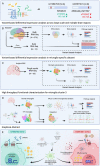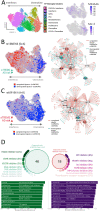This is a preprint.
MS4A4A modifies the risk of Alzheimer disease by regulating lipid metabolism and immune response in a unique microglia state
- PMID: 36798226
- PMCID: PMC9934804
- DOI: 10.1101/2023.02.06.23285545
MS4A4A modifies the risk of Alzheimer disease by regulating lipid metabolism and immune response in a unique microglia state
Abstract
Genome-wide association studies (GWAS) have identified many modifiers of Alzheimer disease (AD) risk enriched in microglia. Two of these modifiers are common variants in the MS4A locus (rs1582763: protective and rs6591561: risk) and serve as major regulators of CSF sTREM2 levels. To understand their functional impact on AD, we used single nucleus transcriptomics to profile brains from carriers of these variants. We discovered a "chemokine" microglial subpopulation that is altered in MS4A variant carriers and for which MS4A4A is the major regulator. The protective variant increases MS4A4A expression and shifts the chemokine microglia subpopulation to an interferon state, while the risk variant suppresses MS4A4A expression and reduces this subpopulation of microglia. Our findings provide a mechanistic explanation for the AD variants in the MS4A locus. Further, they pave the way for future mechanistic studies of AD variants and potential therapeutic strategies for enhancing microglia resilience in AD pathogenesis.
Figures






References
Publication types
Grants and funding
- U01 AG046152/AG/NIA NIH HHS/United States
- RF1 AG071706/AG/NIA NIH HHS/United States
- R01 AG058501/AG/NIA NIH HHS/United States
- R01 AG030146/AG/NIA NIH HHS/United States
- T32 AG058518/AG/NIA NIH HHS/United States
- RC2 AG036547/AG/NIA NIH HHS/United States
- RF1 AG057473/AG/NIA NIH HHS/United States
- R01 NS118146/NS/NINDS NIH HHS/United States
- U01 AG046161/AG/NIA NIH HHS/United States
- R01 AG048015/AG/NIA NIH HHS/United States
- UL1 TR002345/TR/NCATS NIH HHS/United States
- R56 AG067764/AG/NIA NIH HHS/United States
- P30 AG066444/AG/NIA NIH HHS/United States
- R01 AG062734/AG/NIA NIH HHS/United States
- U01 AG032438/AG/NIA NIH HHS/United States
- U01 AG061356/AG/NIA NIH HHS/United States
- U01 AG032984/AG/NIA NIH HHS/United States
- P01 AG003991/AG/NIA NIH HHS/United States
- P50 AG005681/AG/NIA NIH HHS/United States
- P01 AG026276/AG/NIA NIH HHS/United States
- R01 AG017917/AG/NIA NIH HHS/United States
- RF1 AG058501/AG/NIA NIH HHS/United States
- R01 AG036042/AG/NIA NIH HHS/United States
- P30 AG010161/AG/NIA NIH HHS/United States
- R21 NS127211/NS/NINDS NIH HHS/United States
- U19 AG032438/AG/NIA NIH HHS/United States
- R01 AG036836/AG/NIA NIH HHS/United States
- R01 AG015819/AG/NIA NIH HHS/United States
LinkOut - more resources
Full Text Sources
